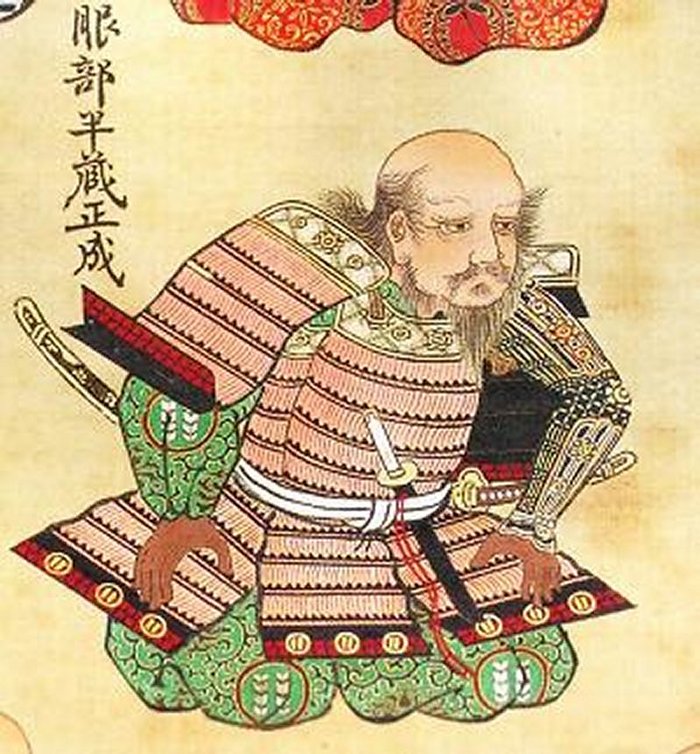Shinobi No Mono: The Shadow Warriors And Hattori ‘The Demon’ Hanzo Of Ancient Japan
Ellen Lloyd - AncientPages.com - Led by Hattori "the Demon" Hanzo, Shinobi no Mono, the Shadow Warriors of the 16th century were incredible ancient Japanese fighters who became known for their seemingly superhuman power and astonishing athletic accomplishments.
Credit: Adobe Stock - breakermaximus
The Shinobi Shadow Warriors were masters in becoming almost invisible through masterful stealth. One of their many helpful fighting skills was to avoid detection. Many credited these fighters with supernatural powers, and it was said that it was already too late to escape if you spotted a Shadow Warrior.
Today, the Shinobi no Mono and the Shadow Warriors are recognized as Ninjas.
In Japanese, the words "nin" and Wshinobi" have the same meaning: "stealth" or "quiet action." The words also mean "to endure." Meanwhile, "sha" and "mono" both mean "person." So a simple translation would be "a person skilled in the art of stealth."
In modern times, Ninjas are regarded as assassins, but historically, the Ninja played an entirely different role. Ninjas were often spies, scouts, and commando-type covert operation forces.
Credit: Adobe Stock - sheikoevgeniya
In 1562 A.D., Japan was a war-like zone. Ongoing civil wars that lasted more than 100 years devastated the country and its people.
Hattori' The Demon' Hanzo Of Ancient Japan
Tokugawa Ieyasu, an ambitious warlord, became the founder and first shogun of the Tokugawa shogunate of Japan, which virtually ruled Japan from the Battle of Sekigahara in 1600 until the Meiji Restoration in 1868.
Tokugawa Ieyasu used several skilled warriors to win battles and strengthen his military power. One of them was Hattori Hanzo (1542-1596), one of the greatest Ninjas of all time.
Hanzo Hattori began his training by climbing a mountain at eight and seeking instruction from the most hardcore ninja masters in Japan. When he was 16, he earned the nicknames "Hanzo the Ghost" and "Devil Hanzo" because of his skills to sneak up on enemies without being seen or heard.
Hanzo made a successful hostage rescue of Tokugawa's daughters in Kaminogo Castle in 1562 and went on to lay siege to Kakegawa Castle in 1569.
He became famous for unconventional warfare. He became the leader of the most elite fighting group in the Japanese world and trained his fighters in the secret martial art of Shinobi.
The Shadow Warriors And Their "Magical Powers"
The Shadow Warriors, trained by Hanzo Hattori, possessed magical powers. Hanzo himself was often attributed to supernatural abilities such as psychokinesis and precognition.
The shinobi, or ninja, is one of the most widely recognized figures in the world of espionage—and also one of the most misrepresented. What do we really know about the historical shinobi, his tactics, and his role in medieval Japanese society? In Secret Traditions of the Shinobi, these questions—and many more—are answered. Translated into English for the very first time, this widely sought-after collection of historical documents brings to light the secret practices, techniques, philosophies, and lifestyles of the shinobi. Read more
The Shinobi, or Ninja, is one of the most widely recognized figures in the world of espionage and one of the most misrepresented. What do we know about the historical Shinobi, his tactics, and his role in medieval Japanese society? In Secret Traditions of the Shinobi, these questions—and many more—are answered. Translated into English for the first time, this widely sought-after collection of historical documents brings to light the Shinobi's secret practices, techniques, philosophies, and lifestyles. Read more
The truth is that these warriors employed unusual military tactics. They could move undetected and vanish without a trace. It was one of the reasons why the Shadow Warriors were predominantly used for commando infiltration raids and information and intelligence gathering. They were considered ancient Japan's most effective resources for espionage.
Shinobi Warriors never infiltrated during the full moon due to the excessive light it reflects off the Sun during the nighttime hours. Instead, they preferred to enter either eight days before or after the full moon when optimal darkness was available. In this style of approach, the Ninja is nearly invisible in his black Shinobi gear.
A portrait of Hanzō Hattori from the 17th century. Unknown - Public Domain
After his death on 4 November 1596, Hattori Hanzo was succeeded by his son, whose name was also Masanari, though written with different kanji. He was given the title of Iwami no Kami, and his Iga Ninjas would act as guards of Edo Castle, the headquarters of the government of united Japan.
The memory of Hattori Hanzon is still very much alive. Tokyo Imperial Palace, which was earlier the shogun's palace, still has a gate called Hanzo's Gate (Hanzomon). The Hanzomon subway line from Hanzomon Station in central Tokyo to the southwestern suburbs is named after the entrance where his house was once located.
Updated on January 16, 2024
Written by Ellen Lloyd – AncientPages.com
Copyright © AncientPages.com All rights reserved. This material may not be published, broadcast, rewritten or redistributed in whole or part without the express written permission of AncientPages.com
Expand for referencesReferences:
Joel Levy - Ninja: The Shadow Warrior
More From Ancient Pages
-
 Why Was Lovesickness A Feared Disease During The Middle Ages?
Ancient History Facts | Feb 8, 2018
Why Was Lovesickness A Feared Disease During The Middle Ages?
Ancient History Facts | Feb 8, 2018 -
 Mystery Of The Horrible ‘Thing’ Found In A Dominican Monastery
Featured Stories | Sep 4, 2023
Mystery Of The Horrible ‘Thing’ Found In A Dominican Monastery
Featured Stories | Sep 4, 2023 -
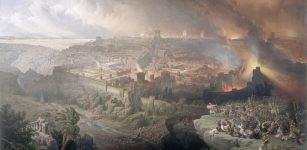 On This Day In History: Siege of Jerusalem: Titus And His Legions Breach The Middle Wall Of The City – On June 5, 70 CE
News | Jun 5, 2016
On This Day In History: Siege of Jerusalem: Titus And His Legions Breach The Middle Wall Of The City – On June 5, 70 CE
News | Jun 5, 2016 -
 Limestone Stela Of Liberation Discovered In Kom Ombo Temple In Aswan, Egypt
Archaeology | Oct 17, 2018
Limestone Stela Of Liberation Discovered In Kom Ombo Temple In Aswan, Egypt
Archaeology | Oct 17, 2018 -
 Unexplained Encounters With A Mysterious Being In South Dakota Reported – Why Is This Happening?
Featured Stories | Jul 9, 2024
Unexplained Encounters With A Mysterious Being In South Dakota Reported – Why Is This Happening?
Featured Stories | Jul 9, 2024 -
 On This Day In History: Storming Of The Paris Fortress – Prison Bastille – On July 14, 1789
News | Jul 14, 2016
On This Day In History: Storming Of The Paris Fortress – Prison Bastille – On July 14, 1789
News | Jul 14, 2016 -
 Rare Ancient Leopard Painting Discovered On Sarcophagus In Aswan, Egypt
Archaeology | Feb 25, 2020
Rare Ancient Leopard Painting Discovered On Sarcophagus In Aswan, Egypt
Archaeology | Feb 25, 2020 -
 Locations Of 11 Lost Ancient Cities Revealed On 4,000-Year-Old Artifacts
Archaeology | Nov 15, 2017
Locations Of 11 Lost Ancient Cities Revealed On 4,000-Year-Old Artifacts
Archaeology | Nov 15, 2017 -
 A 500-Year-Old Stolen Copy Of da Vinci’s “Salvator Mundi” Painting – Found By Italian Police
News | Jan 20, 2021
A 500-Year-Old Stolen Copy Of da Vinci’s “Salvator Mundi” Painting – Found By Italian Police
News | Jan 20, 2021 -
 Ancient Necropolis With Lead Coffins Sheds Light On Early Christian Funeral Practices
Archaeology | Jul 13, 2020
Ancient Necropolis With Lead Coffins Sheds Light On Early Christian Funeral Practices
Archaeology | Jul 13, 2020 -
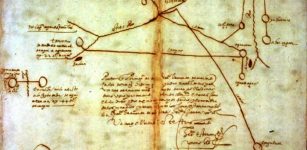 Etzanoa: Long-Lost Native American City Discovered In Kansas After 400 Years
Archaeology | Apr 24, 2017
Etzanoa: Long-Lost Native American City Discovered In Kansas After 400 Years
Archaeology | Apr 24, 2017 -
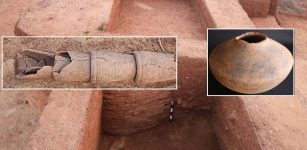 2,000-Year-Old Trade Center: Brick Structure, A Vishnu Sculpture Among Findings In Andhra Pradesh
Archaeology | Nov 6, 2019
2,000-Year-Old Trade Center: Brick Structure, A Vishnu Sculpture Among Findings In Andhra Pradesh
Archaeology | Nov 6, 2019 -
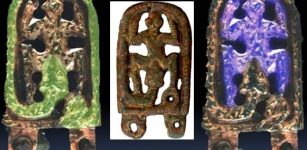 Unique Medieval Bronze Buckle Of A Snake Devouring A Frog-Like Creature Found In Brno, Czech Republic
Archaeology | Dec 13, 2023
Unique Medieval Bronze Buckle Of A Snake Devouring A Frog-Like Creature Found In Brno, Czech Republic
Archaeology | Dec 13, 2023 -
 900-Year-Old Crypt At Old Dongola: Magical Inscriptions And Mysterious Signs Found
Archaeology | Sep 12, 2015
900-Year-Old Crypt At Old Dongola: Magical Inscriptions And Mysterious Signs Found
Archaeology | Sep 12, 2015 -
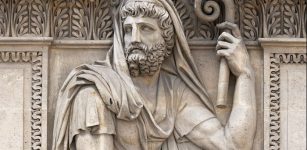 Numa Pompilius – Remarkable Legendary Second King Of Ancient Rome Who Succeeded Romulus – Did He Ever Exist?
Featured Stories | Mar 2, 2018
Numa Pompilius – Remarkable Legendary Second King Of Ancient Rome Who Succeeded Romulus – Did He Ever Exist?
Featured Stories | Mar 2, 2018 -
 Huge Ancient Underwater Structure And Stunning Artifacts Discovered Off The Coast Of Salamis
Archaeology | Jun 26, 2019
Huge Ancient Underwater Structure And Stunning Artifacts Discovered Off The Coast Of Salamis
Archaeology | Jun 26, 2019 -
 Mysterious Tiahuanaco Empire Established By The Sons Of The Sun – An Unknown Chapter Of Prehistory
Ancient Mysteries | Oct 30, 2018
Mysterious Tiahuanaco Empire Established By The Sons Of The Sun – An Unknown Chapter Of Prehistory
Ancient Mysteries | Oct 30, 2018 -
 New Discovery: 2,000-Year-Old Monumental Street In Jerusalem Built By Pontius Pilate
Archaeology | Oct 21, 2019
New Discovery: 2,000-Year-Old Monumental Street In Jerusalem Built By Pontius Pilate
Archaeology | Oct 21, 2019 -
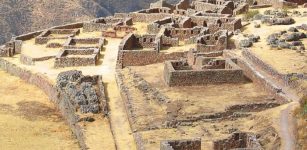 Beautiful Ancient City Of Pisac In The Sacred Valley, Peru – Incredible Inca Ruins
Featured Stories | Jun 22, 2017
Beautiful Ancient City Of Pisac In The Sacred Valley, Peru – Incredible Inca Ruins
Featured Stories | Jun 22, 2017 -
 Controversial 5,500-Year-Old Sumerian Star Map Of Ancient Nineveh Reveals Observation Of Köfels’ Impact Event
Artifacts | Dec 28, 2018
Controversial 5,500-Year-Old Sumerian Star Map Of Ancient Nineveh Reveals Observation Of Köfels’ Impact Event
Artifacts | Dec 28, 2018




